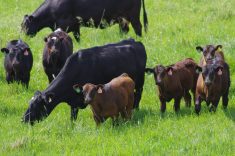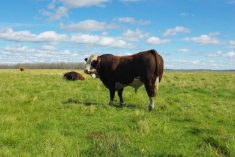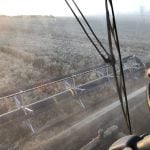New research has found that feedlot cattle can develop problems when fed ergot even within allowable limits.
Ergot is a fungus that can grow on certain grasses and grain plants when moisture conditions are just right. It becomes a problem mainly after a wet growing season. The fungus replaces the seed head with a dark brown/black mass and produces toxic alkaloids. The strains in Western Canada tend to be more virulent and harmful than what is generally seen in the U.S.
Some ergot alkaloids affect the nervous system, resulting in muscle spasms in the hind legs, loss of balance, inco-ordination and sometimes temporary paralysis. More commonly, the toxic alkaloids impair blood circulation to the extremities, which can result in loss of ears, tail or feet. Mild cases of ergot poisoning may show up as poor production (lower weight gain, drop in milk production, inability to handle hot or cold weather, reproductive problems, or abortion).
Read Also

The Canadian Cattle Association’s international advocacy efforts
Global ag policies affect Canadian food policy, so the Canadian Cattle Association participates in international and domestic forums
Jenna Sarich is a graduate student at the University of Saskatchewan who has been researching ergot levels in cattle feed. She’s finding that cattle fed ergot even within Canadian Food Inspection Agency (CFIA) levels can struggle, especially as the mercury climbs.
Sarich is working with Dr. Gabriel Ribeiro, an assistant professor and the Saskatchewan Beef Industry chair at the University of Saskatchewan. Her master’s project comprises three different studies.
“In the first one, we were taking samples from across Western Canada, and analyzing the profiles of these ergot-contaminated feed samples. We were trying to make a link, to see if the toxicity of ergot changes, based on location, climate within that location, or the crop it was growing in,” she says.
Next, they studied ergot in the rumen of an animal. “We did it in vitro, however, rather than in an actual animal. We used a lab device instead, collecting rumen fluid and digesta (feed material from the gut) from a cannulated animal and put it into an artificial rumen known as a RUSITEC, a semi-continuous in-vitro system. It has artificial saliva coming in, just like an animal would swallow, and has a port for liquid coming out — like it would leave the rumen. We were able to collect the gas produced and it also had continuous mixing, to simulate actual rumen contractions. We ‘fed’ the ergot into this, at toxic levels of 20 ppm, to see its effects on the microbiome within the simulated rumen. We also fed a mycotoxin binder, to see if this might help alleviate the impact,” Sarich says. This study has been published in the Journal of Animal Science.

The third part of her project involved feedlot cattle. Researchers obtained animal care approval from the University of Saskatchewan Animal Research Ethics Board before beginning the project, which took place at the Livestock and Forage Centre of Excellence’s feedlot.
Sarich and her colleagues separated 240 steers into 16 pens. Researchers gave the steers feed with different ergot levels, all within the CFIA level, which is two to three ppm.
“Ergot changes its toxicity, depending on many factors, so it’s very difficult to pinpoint exactly how much would be safe within the diet of an animal,” says Sarich. The steers’ diets had ergot alkaloids included at increasing levels, ranging from zero (control, without ergot), 0.75 to 1.5 and three ppm.
The study covered the entire feedlot cycle, beginning with the backgrounding period in early November and running to the end of finishing in late June for a total of 231 days.
“We saw some effects during the backgrounding, but these were not as evident as later. Coming into the finishing phase we started seeing some symptoms after the daytime temperatures reached about 20 C. The animals that were on the three ppm diet began to have increased respiratory rate and open-mouthed panting. They had increased saliva and heat stress symptoms. We also saw them splashing in their watering bowl, trying to cool themselves,” Sarich says.
This created muddy conditions in the pens. The cattle would then lie in the mud to try to cool off.
“When we were walking through the pen, we’d know which cattle were receiving the three ppm level in their feed, just by the state of their pen,” she says. After a short time, they decided to take the animals off the three ppm diet as the weather that spring was hot, and it looked like it was only going to get hotter.
On May 13, researchers started feeding the animals the control diet. This wasn’t a part of the study but it did add an interesting facet.
“We saw these animals experience a significant drop in dry matter intake and average daily gain when they showed signs of heat stress. When we took them off the ergot and started feeding them the control diet, by the end of the study — about 40 days later — they had significant compensatory gain and ended up being about the same weight as the control animals. It was interesting to see that those animals were able to bounce back after we took them off the ergot. Animals receiving the second-highest concentration of 1.5 ppm continued to have reduced growth performance, but to a lesser extent than the animals on the three ppm diet,” she says.
The response to the change was immediate. “We did continue to see some heat stress signs in those animals, but their gain increased a lot. There is something about ergot that does produce prolonged effects, but there is also the acute effect on growth performance.”
There was a significant increase in body temperature in those animals on high levels of ergot. “Their temperature and growth performance was linear; the more increase of ergot in the diet, the more their body temperature increased, with a parallel decrease in performance.”
During the study, many other measurements were taken as well. Ergot causes specific symptoms affecting vasoconstriction; if the animals consumed ergot at toxic levels, the blood vessels constrict.
“They may lose blood flow to their ears, tail and limbs. Because of this factor, we also had some welfare parameters in our study. I took thermogram images of the animal’s head and ears, to ensure that we could see any changes in blood flow to the ears,” Sarich says. “Thermography involves using a camera that picks up heat, so we used that during sampling and when we weighed the cattle.”
Researchers also checked the feet for any lameness due to constricted blood flow. “We used two lasers, similar to what they use in barrel racing; when the steer crossed the first one the timer would start and when he crossed the second one the timer stops. This enabled us to see if the animals were decreasing or increasing their speed coming out of the chute. This could be indicative of lameness, or stress,” she says. They also used Grow-Safe systems to measure individual feed intake and behaviour, she adds, but are still analyzing data on some of these parameters.
“The information that we already have ready to go in our presentations includes growth performance, body temperature, blood and hair parameters, and carcass performance.”
So what’s the bottom line? The results of this study show that cattle producers should be feeding less than 1.5 ppm in rations, especially in warmer weather, since performance and welfare of the animals were affected when consuming levels higher than 0.75 ppm.
















